Dominic's Tax Obligations: FBT, Capital Gains, and Deductions
VerifiedAdded on 2023/01/11
|7
|1299
|55
Project
AI Summary
This project analyzes Dominic's tax obligations for the year ended 31 March 2019 and 30 June 2019. Part 1 focuses on Fringe Benefits Tax (FBT) calculations, comparing the statutory and operating cost methods for a company vehicle, concluding that the operating cost method results in a lower taxable value. Part 2 addresses Dominic's net capital gain or loss, calculating capital gains from the sale of a rental property, shares, a clock, and a car, ultimately determining a net capital gain for the year. Part 3 examines income tax deductions Dominic can claim, including interest on a loan for the rental property and deductions for private health insurance premiums paid for employees. The project references relevant books and journals to support the analysis.

Project
Paraphrase This Document
Need a fresh take? Get an instant paraphrase of this document with our AI Paraphraser
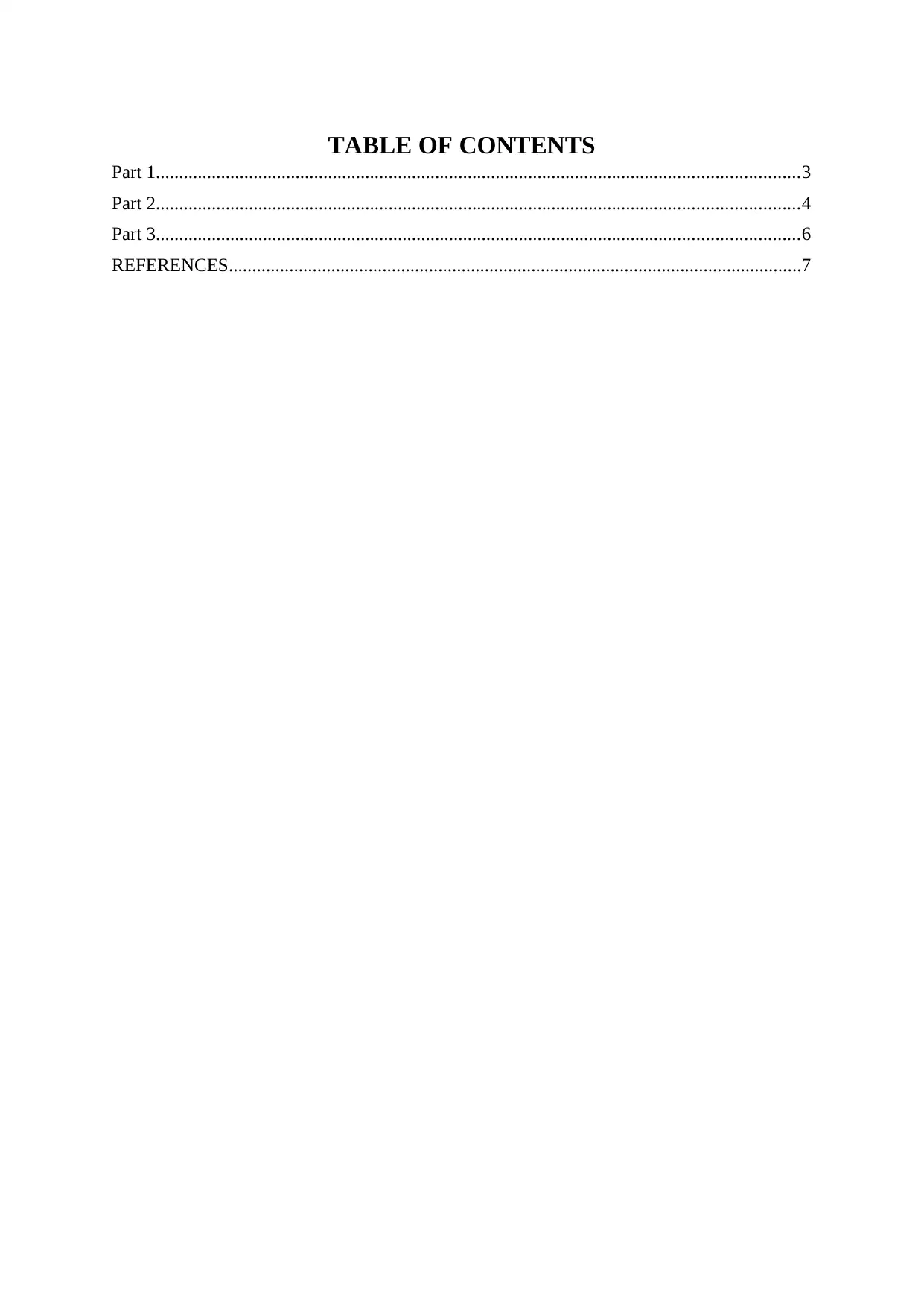
TABLE OF CONTENTS
Part 1..........................................................................................................................................3
Part 2..........................................................................................................................................4
Part 3..........................................................................................................................................6
REFERENCES...........................................................................................................................7
Part 1..........................................................................................................................................3
Part 2..........................................................................................................................................4
Part 3..........................................................................................................................................6
REFERENCES...........................................................................................................................7
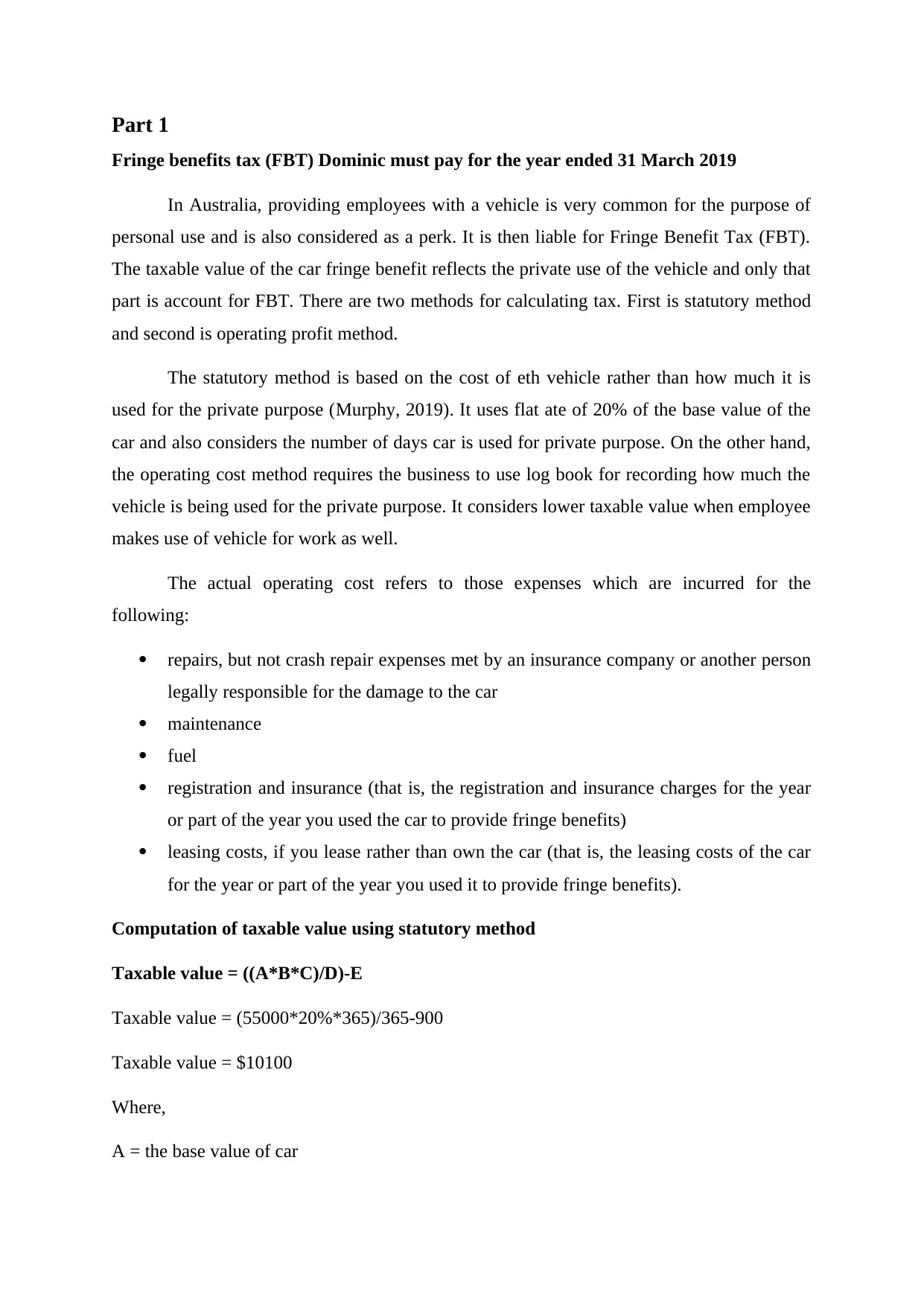
Part 1
Fringe benefits tax (FBT) Dominic must pay for the year ended 31 March 2019
In Australia, providing employees with a vehicle is very common for the purpose of
personal use and is also considered as a perk. It is then liable for Fringe Benefit Tax (FBT).
The taxable value of the car fringe benefit reflects the private use of the vehicle and only that
part is account for FBT. There are two methods for calculating tax. First is statutory method
and second is operating profit method.
The statutory method is based on the cost of eth vehicle rather than how much it is
used for the private purpose (Murphy, 2019). It uses flat ate of 20% of the base value of the
car and also considers the number of days car is used for private purpose. On the other hand,
the operating cost method requires the business to use log book for recording how much the
vehicle is being used for the private purpose. It considers lower taxable value when employee
makes use of vehicle for work as well.
The actual operating cost refers to those expenses which are incurred for the
following:
repairs, but not crash repair expenses met by an insurance company or another person
legally responsible for the damage to the car
maintenance
fuel
registration and insurance (that is, the registration and insurance charges for the year
or part of the year you used the car to provide fringe benefits)
leasing costs, if you lease rather than own the car (that is, the leasing costs of the car
for the year or part of the year you used it to provide fringe benefits).
Computation of taxable value using statutory method
Taxable value = ((A*B*C)/D)-E
Taxable value = (55000*20%*365)/365-900
Taxable value = $10100
Where,
A = the base value of car
Fringe benefits tax (FBT) Dominic must pay for the year ended 31 March 2019
In Australia, providing employees with a vehicle is very common for the purpose of
personal use and is also considered as a perk. It is then liable for Fringe Benefit Tax (FBT).
The taxable value of the car fringe benefit reflects the private use of the vehicle and only that
part is account for FBT. There are two methods for calculating tax. First is statutory method
and second is operating profit method.
The statutory method is based on the cost of eth vehicle rather than how much it is
used for the private purpose (Murphy, 2019). It uses flat ate of 20% of the base value of the
car and also considers the number of days car is used for private purpose. On the other hand,
the operating cost method requires the business to use log book for recording how much the
vehicle is being used for the private purpose. It considers lower taxable value when employee
makes use of vehicle for work as well.
The actual operating cost refers to those expenses which are incurred for the
following:
repairs, but not crash repair expenses met by an insurance company or another person
legally responsible for the damage to the car
maintenance
fuel
registration and insurance (that is, the registration and insurance charges for the year
or part of the year you used the car to provide fringe benefits)
leasing costs, if you lease rather than own the car (that is, the leasing costs of the car
for the year or part of the year you used it to provide fringe benefits).
Computation of taxable value using statutory method
Taxable value = ((A*B*C)/D)-E
Taxable value = (55000*20%*365)/365-900
Taxable value = $10100
Where,
A = the base value of car
⊘ This is a preview!⊘
Do you want full access?
Subscribe today to unlock all pages.

Trusted by 1+ million students worldwide
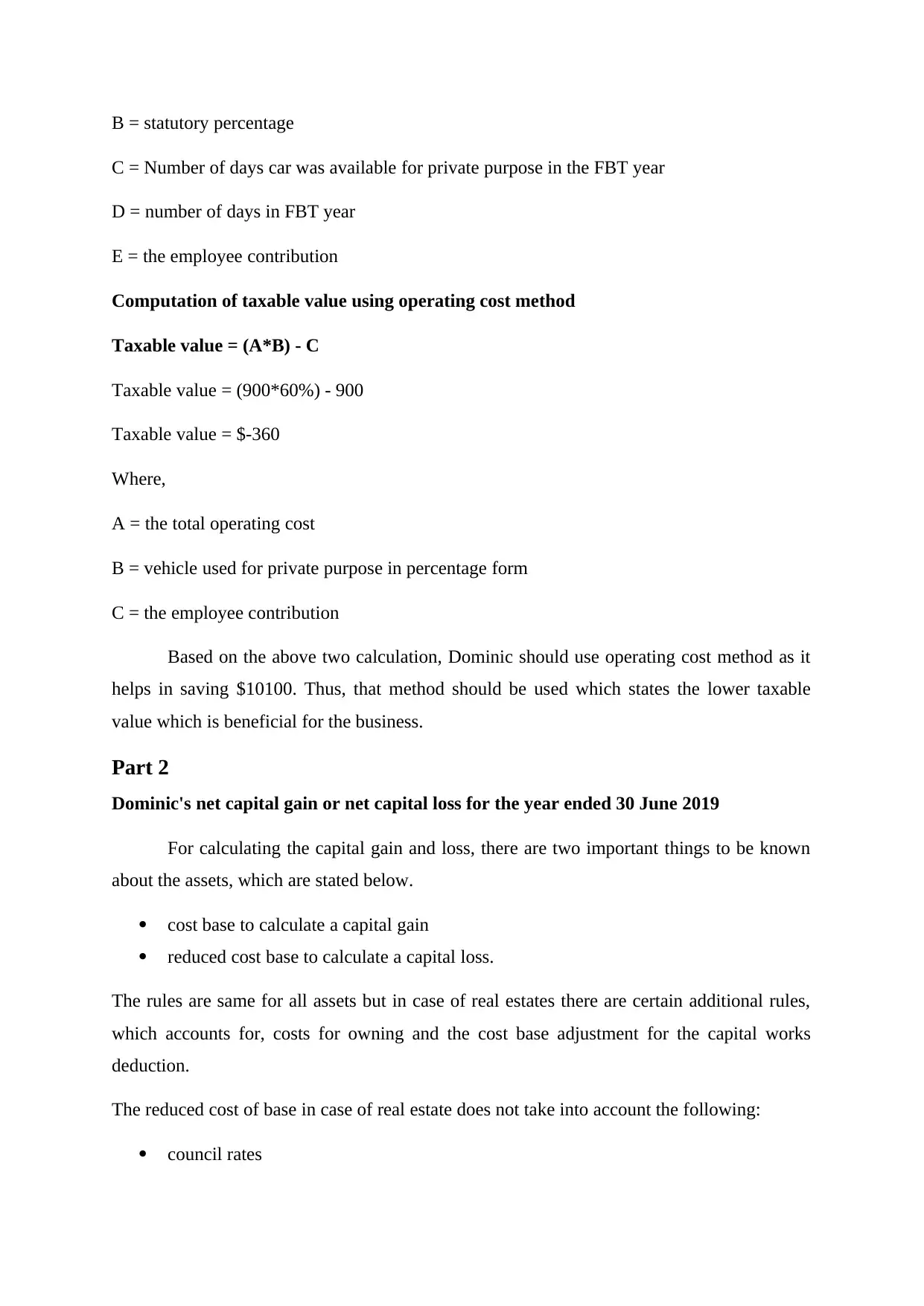
B = statutory percentage
C = Number of days car was available for private purpose in the FBT year
D = number of days in FBT year
E = the employee contribution
Computation of taxable value using operating cost method
Taxable value = (A*B) - C
Taxable value = (900*60%) - 900
Taxable value = $-360
Where,
A = the total operating cost
B = vehicle used for private purpose in percentage form
C = the employee contribution
Based on the above two calculation, Dominic should use operating cost method as it
helps in saving $10100. Thus, that method should be used which states the lower taxable
value which is beneficial for the business.
Part 2
Dominic's net capital gain or net capital loss for the year ended 30 June 2019
For calculating the capital gain and loss, there are two important things to be known
about the assets, which are stated below.
cost base to calculate a capital gain
reduced cost base to calculate a capital loss.
The rules are same for all assets but in case of real estates there are certain additional rules,
which accounts for, costs for owning and the cost base adjustment for the capital works
deduction.
The reduced cost of base in case of real estate does not take into account the following:
council rates
C = Number of days car was available for private purpose in the FBT year
D = number of days in FBT year
E = the employee contribution
Computation of taxable value using operating cost method
Taxable value = (A*B) - C
Taxable value = (900*60%) - 900
Taxable value = $-360
Where,
A = the total operating cost
B = vehicle used for private purpose in percentage form
C = the employee contribution
Based on the above two calculation, Dominic should use operating cost method as it
helps in saving $10100. Thus, that method should be used which states the lower taxable
value which is beneficial for the business.
Part 2
Dominic's net capital gain or net capital loss for the year ended 30 June 2019
For calculating the capital gain and loss, there are two important things to be known
about the assets, which are stated below.
cost base to calculate a capital gain
reduced cost base to calculate a capital loss.
The rules are same for all assets but in case of real estates there are certain additional rules,
which accounts for, costs for owning and the cost base adjustment for the capital works
deduction.
The reduced cost of base in case of real estate does not take into account the following:
council rates
Paraphrase This Document
Need a fresh take? Get an instant paraphrase of this document with our AI Paraphraser
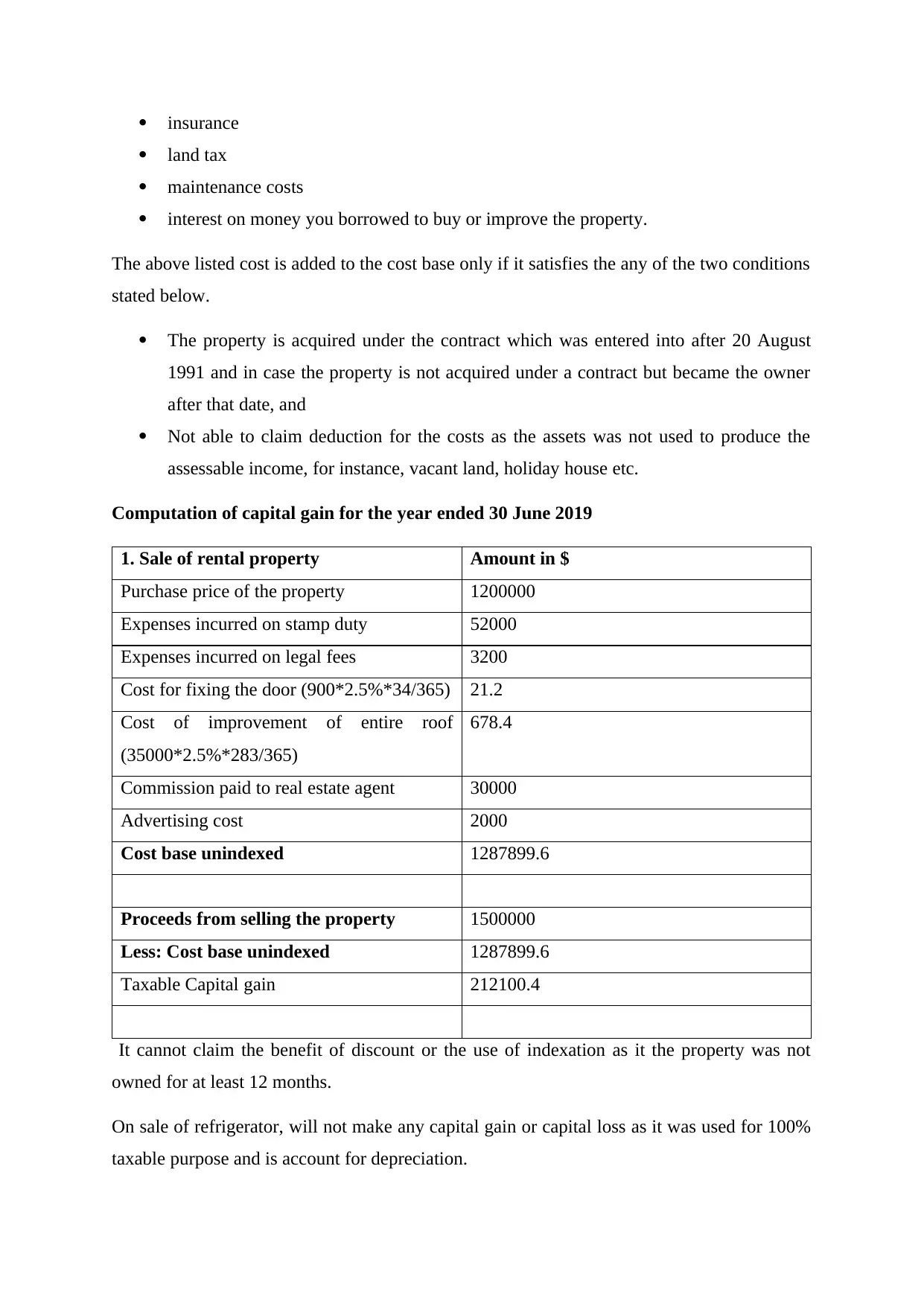
insurance
land tax
maintenance costs
interest on money you borrowed to buy or improve the property.
The above listed cost is added to the cost base only if it satisfies the any of the two conditions
stated below.
The property is acquired under the contract which was entered into after 20 August
1991 and in case the property is not acquired under a contract but became the owner
after that date, and
Not able to claim deduction for the costs as the assets was not used to produce the
assessable income, for instance, vacant land, holiday house etc.
Computation of capital gain for the year ended 30 June 2019
1. Sale of rental property Amount in $
Purchase price of the property 1200000
Expenses incurred on stamp duty 52000
Expenses incurred on legal fees 3200
Cost for fixing the door (900*2.5%*34/365) 21.2
Cost of improvement of entire roof
(35000*2.5%*283/365)
678.4
Commission paid to real estate agent 30000
Advertising cost 2000
Cost base unindexed 1287899.6
Proceeds from selling the property 1500000
Less: Cost base unindexed 1287899.6
Taxable Capital gain 212100.4
It cannot claim the benefit of discount or the use of indexation as it the property was not
owned for at least 12 months.
On sale of refrigerator, will not make any capital gain or capital loss as it was used for 100%
taxable purpose and is account for depreciation.
land tax
maintenance costs
interest on money you borrowed to buy or improve the property.
The above listed cost is added to the cost base only if it satisfies the any of the two conditions
stated below.
The property is acquired under the contract which was entered into after 20 August
1991 and in case the property is not acquired under a contract but became the owner
after that date, and
Not able to claim deduction for the costs as the assets was not used to produce the
assessable income, for instance, vacant land, holiday house etc.
Computation of capital gain for the year ended 30 June 2019
1. Sale of rental property Amount in $
Purchase price of the property 1200000
Expenses incurred on stamp duty 52000
Expenses incurred on legal fees 3200
Cost for fixing the door (900*2.5%*34/365) 21.2
Cost of improvement of entire roof
(35000*2.5%*283/365)
678.4
Commission paid to real estate agent 30000
Advertising cost 2000
Cost base unindexed 1287899.6
Proceeds from selling the property 1500000
Less: Cost base unindexed 1287899.6
Taxable Capital gain 212100.4
It cannot claim the benefit of discount or the use of indexation as it the property was not
owned for at least 12 months.
On sale of refrigerator, will not make any capital gain or capital loss as it was used for 100%
taxable purpose and is account for depreciation.
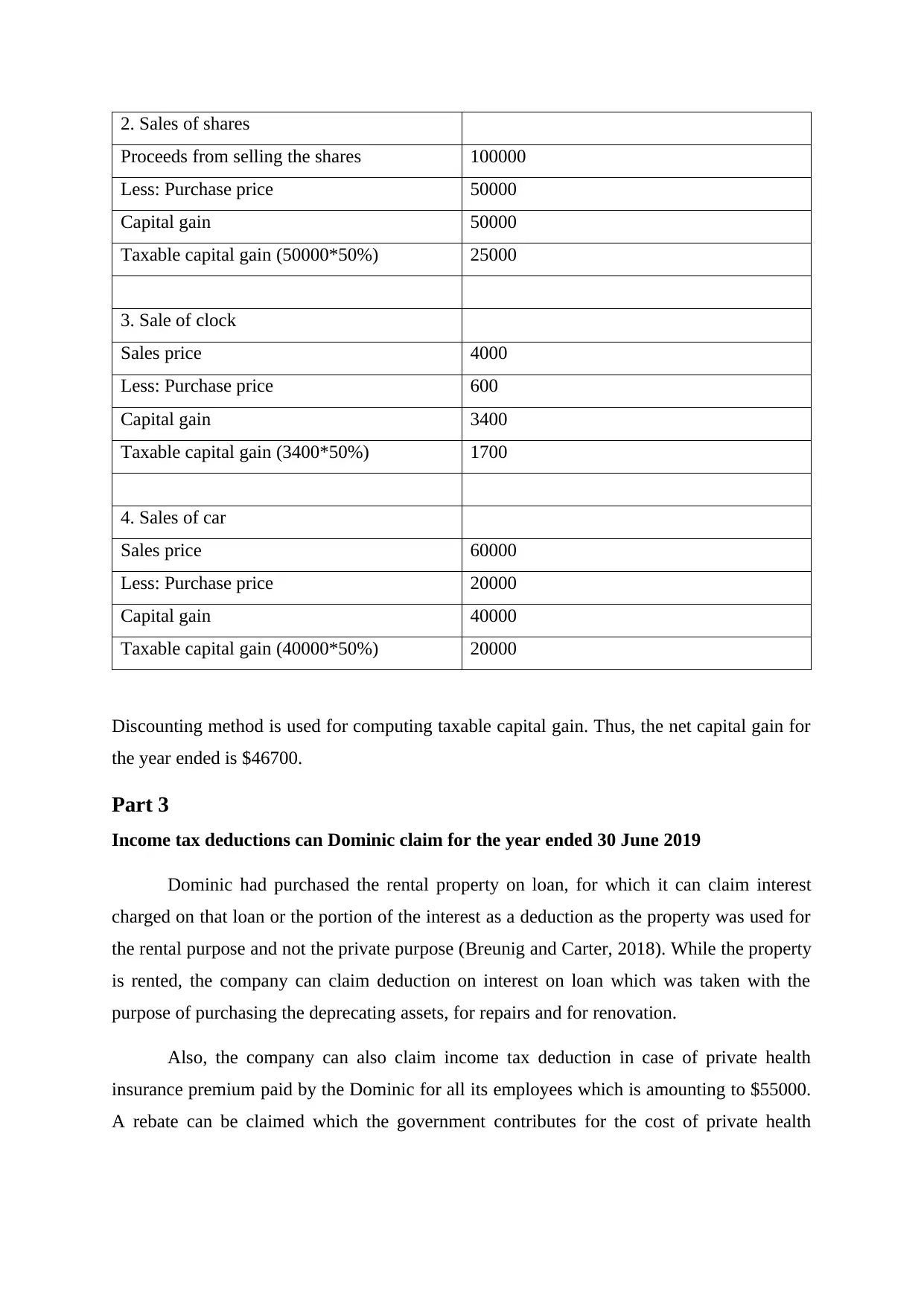
2. Sales of shares
Proceeds from selling the shares 100000
Less: Purchase price 50000
Capital gain 50000
Taxable capital gain (50000*50%) 25000
3. Sale of clock
Sales price 4000
Less: Purchase price 600
Capital gain 3400
Taxable capital gain (3400*50%) 1700
4. Sales of car
Sales price 60000
Less: Purchase price 20000
Capital gain 40000
Taxable capital gain (40000*50%) 20000
Discounting method is used for computing taxable capital gain. Thus, the net capital gain for
the year ended is $46700.
Part 3
Income tax deductions can Dominic claim for the year ended 30 June 2019
Dominic had purchased the rental property on loan, for which it can claim interest
charged on that loan or the portion of the interest as a deduction as the property was used for
the rental purpose and not the private purpose (Breunig and Carter, 2018). While the property
is rented, the company can claim deduction on interest on loan which was taken with the
purpose of purchasing the deprecating assets, for repairs and for renovation.
Also, the company can also claim income tax deduction in case of private health
insurance premium paid by the Dominic for all its employees which is amounting to $55000.
A rebate can be claimed which the government contributes for the cost of private health
Proceeds from selling the shares 100000
Less: Purchase price 50000
Capital gain 50000
Taxable capital gain (50000*50%) 25000
3. Sale of clock
Sales price 4000
Less: Purchase price 600
Capital gain 3400
Taxable capital gain (3400*50%) 1700
4. Sales of car
Sales price 60000
Less: Purchase price 20000
Capital gain 40000
Taxable capital gain (40000*50%) 20000
Discounting method is used for computing taxable capital gain. Thus, the net capital gain for
the year ended is $46700.
Part 3
Income tax deductions can Dominic claim for the year ended 30 June 2019
Dominic had purchased the rental property on loan, for which it can claim interest
charged on that loan or the portion of the interest as a deduction as the property was used for
the rental purpose and not the private purpose (Breunig and Carter, 2018). While the property
is rented, the company can claim deduction on interest on loan which was taken with the
purpose of purchasing the deprecating assets, for repairs and for renovation.
Also, the company can also claim income tax deduction in case of private health
insurance premium paid by the Dominic for all its employees which is amounting to $55000.
A rebate can be claimed which the government contributes for the cost of private health
⊘ This is a preview!⊘
Do you want full access?
Subscribe today to unlock all pages.

Trusted by 1+ million students worldwide
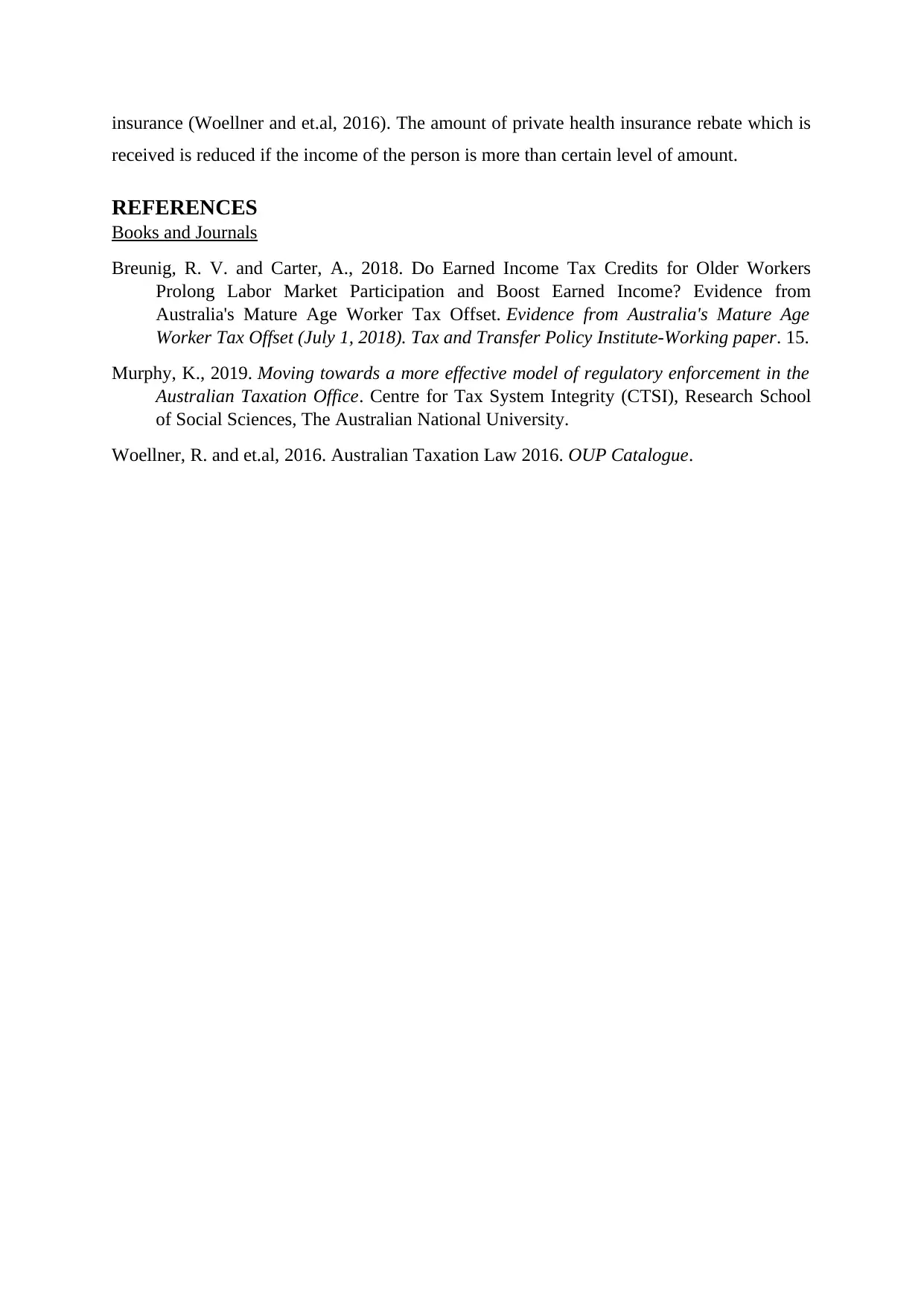
insurance (Woellner and et.al, 2016). The amount of private health insurance rebate which is
received is reduced if the income of the person is more than certain level of amount.
REFERENCES
Books and Journals
Breunig, R. V. and Carter, A., 2018. Do Earned Income Tax Credits for Older Workers
Prolong Labor Market Participation and Boost Earned Income? Evidence from
Australia's Mature Age Worker Tax Offset. Evidence from Australia's Mature Age
Worker Tax Offset (July 1, 2018). Tax and Transfer Policy Institute-Working paper. 15.
Murphy, K., 2019. Moving towards a more effective model of regulatory enforcement in the
Australian Taxation Office. Centre for Tax System Integrity (CTSI), Research School
of Social Sciences, The Australian National University.
Woellner, R. and et.al, 2016. Australian Taxation Law 2016. OUP Catalogue.
received is reduced if the income of the person is more than certain level of amount.
REFERENCES
Books and Journals
Breunig, R. V. and Carter, A., 2018. Do Earned Income Tax Credits for Older Workers
Prolong Labor Market Participation and Boost Earned Income? Evidence from
Australia's Mature Age Worker Tax Offset. Evidence from Australia's Mature Age
Worker Tax Offset (July 1, 2018). Tax and Transfer Policy Institute-Working paper. 15.
Murphy, K., 2019. Moving towards a more effective model of regulatory enforcement in the
Australian Taxation Office. Centre for Tax System Integrity (CTSI), Research School
of Social Sciences, The Australian National University.
Woellner, R. and et.al, 2016. Australian Taxation Law 2016. OUP Catalogue.
1 out of 7
Related Documents
Your All-in-One AI-Powered Toolkit for Academic Success.
+13062052269
info@desklib.com
Available 24*7 on WhatsApp / Email
![[object Object]](/_next/static/media/star-bottom.7253800d.svg)
Unlock your academic potential
Copyright © 2020–2025 A2Z Services. All Rights Reserved. Developed and managed by ZUCOL.





